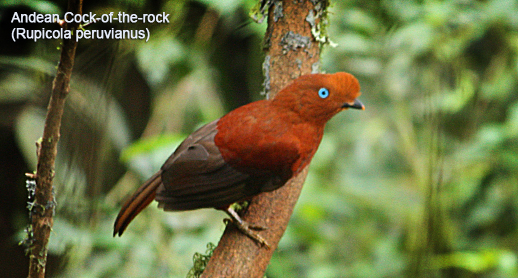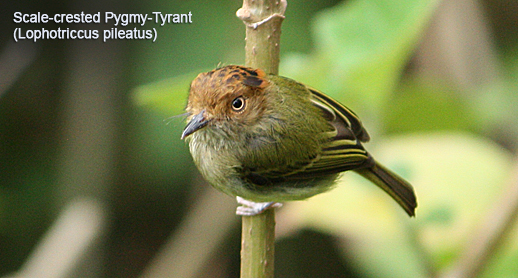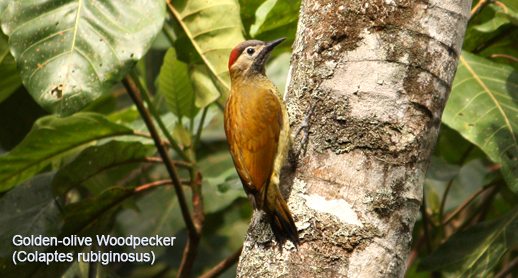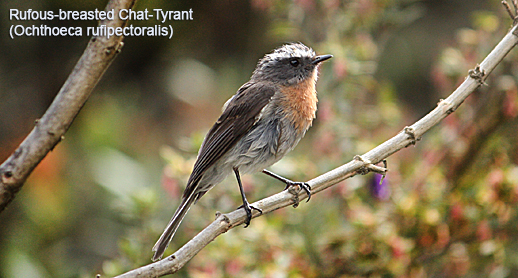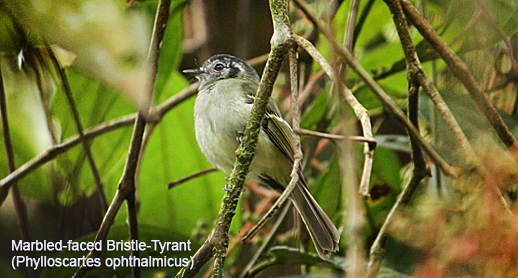BIRDING MANU NATIONAL PARK 4 DAYS
 Manu Biosphere Reserve has the highest biodiversity of any protected area in the world. The unparalleled beauty of this trip is in the landscape and variety of habitats ranging from orchid-draped cloud forest where Spectacled Bears and Cock-of-the-Rocks still exist unbothered, to pristine Amazon rainforest with 13 primate species and oxbow lakes frequented by Giant Otters. A trip to Manu is a trip to one of the world´s great wilderness areas where wildlife is still plentiful and over 1000 species of birds have been recorded. Add to this a breathtaking visit to Machu Picchu and you have a trip of a lifetime.
Manu Biosphere Reserve has the highest biodiversity of any protected area in the world. The unparalleled beauty of this trip is in the landscape and variety of habitats ranging from orchid-draped cloud forest where Spectacled Bears and Cock-of-the-Rocks still exist unbothered, to pristine Amazon rainforest with 13 primate species and oxbow lakes frequented by Giant Otters. A trip to Manu is a trip to one of the world´s great wilderness areas where wildlife is still plentiful and over 1000 species of birds have been recorded. Add to this a breathtaking visit to Machu Picchu and you have a trip of a lifetime.
Day 1: Cusco to Wayqecha Biological Station (2950m)
Today we will leave early, first driving through scenic intermontane valleys. We will make selected stops for two smart endemics: Creamy-crested Spinetail and Chestnut-breasted Mountain-Finch. In addition we may find Cinereous Conebill, Golden-billed Saltator, Band-tailed Seedeater, Peruvian and Ash-breasted Sierra-Finches and many more. Reaching a high mountain pass at Acjanaco, we will begin our journey into a vast intact wilderness area as we descend along the sinuous road that will take us to the Manu foothills.
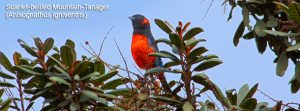
Along the extraordinary altitudinal transect that this remarkable road represents, new bird species continually appear whilst others drop out. Initially the steep Andean slopes are clad in stunted forest, temperate shrubbery and wet paramo, and here we may well encounter such high-elevation species as Mountain Caracara, Shining Sunbeam, Bar-winged Cinclodes, Puna Thistletail, Tufted Tit-Tyrant and Black-throated and Moustached Flower-piercers. A little lower down, where the magnificent cloudforests begin, we shall look out for White-throated and Variable Hawks soaring over the impressive slopes. With a little luck we will see a Swallow-tailed Nightjar this evening. We will stay for one night at the Wayqecha Biological Station. In upper Manu-cloudforest. L:D.
Day 2: Wayqecha to Cock-of-the-rock Lodge
Today we´ll target some tough birds like: Crimson-mantled Woodpecker, Blue-banded Toucanet, the hummingbirds may include Gould´s Inca, Chestnut-breasted Coronet, Amethyst-throated Sunangel, Violet-throated Starfrontlet, Tyrian Metaltail and Rufous-capped Thornbill. Sorting through mixed flocks, we hope to find Montane Woodcreeper, Marcapata Spinetail, Pearled Treerunner, Streaked Tuftedcheek, White-throated and White-banded Tyrannulets, Handsome and Inca Flycatchers, Barred Becard, Mountain Wren, Spectacled Redstart, Citrine and Pale-legged Warblers, Capped Conebill, Blue-and-black, Golden-collared, Blue-capped, Rust-and-yellow and Grass-green Tanagers, Hooded and chestnut-bellied Mountain-Tanagers, Yellow-whiskered Bush-Tanager, and Black-capped, Black-eared and Superciliaried Hemispinguses. Additional species we may find in this area include Andean Guan, Speckle-faced and Scaly-naped Parrots, Andean Pygmy-Owl, Azara´s Spinetail, Striped Treehunter, the endemic but hard to see Red-and-white Antpitta, Trilling Tapaculo, Barred and Band-tailed Fruiteaters, Red-crested Cotinga, Sierran Elaenia, Black-throated Tody-Tyrant, Olive and Pale-edged Flycatchers, Rufous-breasted and Slaty-backed Chat-Tyrants, Streak-throated Bush-Tyrant, White-winged Black-Tyrant, Blue-and-white and Pale-footed Swallows, White-collared Jay, Fulvous Wren, Glossy-black, Great and Chiguanco Thrushes, Scarlet-bellied Mountain-Tanager and Mountain Cacique. Night in Cock of the rock Lodge. B:L:D.
Day 3: Cock-of-the-rock Lodge (Lower Manu cloud forest 1400m)
Birding the Manu road to the comfortable subtropical and lower temperate life zones with their spectacular avifauna. In a short distance is a lek of the Andean Cock-of-the-Rock. The most spectacular of the birds of paradise, the displays of these splendid birds and their unearthly strangled shrieks will be emblazoned in our memories for years to come. Near the lodge we shall search for such specialities as Black-billed Treehunter, Slaty Gnateater, Cinnamon-faced Tyrannulet, Versicoloured Barbet, Golden-olive Woodpecker, Olive-backed Woodcreeper, Montane Foliage-gleaner, Yellow-breasted Antwren, Streak-necked and Slaty-capped Flycatchers, Bolivian Tyrannulet, Marble-faced Bristle-Tyrant, Grey-mantled Wren, Andean and White-eared Solitaires, Brown-capped Vireo, Tropical Parula, Russet-crowned and Three-striped Warblers, Slate-throated Redstart, Deep-blue and Bluish Flower-piercers, Blue-naped Chlorophonia, Fawn-breasted, Orange-eared, Golden, Saffron-crowned, Yellow-throated and Slaty Tanagers, Yellow-throated and Common Bush-Tanagers, Black-faced Brush-Finch, Golden-headed and Crested Quetzals and Hummingbirds such jewels as Violet-fronted Brilliant, Many-spotted Hummingbird, Speckled Hummingbird, Booted Rackettail, Long-tailed Sylph and as the morning sun warms up the crisp air we shall scan the skies for these huge raptors. Solitary and Black-and-chestnut Eagles, additional birds we may encounter here include Band-tailed Pigeon, Chestnut-collared Swift, Masked Trogon, Highland Motmot, Amazonian Umbrellabird, Yungas Manakin, White-crowned Tapaculo, Cinnamon, Lemon-browed and Golden-crowned Flycatchers, Smoke-coloured Pewee, Green Jay, Grey-breasted Wood-Wren, Two-banded Warbler, Dusky-green Oropendola, Olivaceous Siskin and a dazzling array of tanagers. At nights we search for Rufescent Screech-Owl and Lyre-tailed Nightjar. Night in Cock-of-the-rock Lodge. B:L:D.
NOTE: If Wayqecha and Cock-of-the-rock Logde are full we´ll stay at the nearby very comfortable Paradise Lodge
Day 4: Cock-of-the-rock Lodge to Cusco
After some final birding in lower Manu cloud forest, we will travel back to Cusco picking up species we may missed.
TOUR INFORMATION 2022
PRICE: min. 2 passengers — based in double occupancy.
INCLUDED: All Lodging, Meals, transpotation, Expert bilingual birdguide, Hotel transfer and entrance fees.
NOT INCLUDED: Personal expenses
TRIP CONSIDERATIONS
Walking: The walking effort is easy to moderate.
Climate: Rather variable. At high altitudes conditions range from cool to decidedly cold in the early morning. At middle elevations many days are dry and sunny, and overcast.
ACCOMMODATION: The jungle lodges are comfortable but simple; some do not have full-time electricity, but provide a generator for a few hours a day to charge batteries. Wayqecha Biological Station with shared bathroom facilities. Single rooms are not available at Wayqecha Research Center, but we will find you a roommate of the same sex if you are booking as a single. Cock-of-the-rock Lodge consists in double rooms with a private toilet and shower facilities. Hot and cold water is always available and all toilets facilities are flush.
Bird Photography: Opportunities are worthwhile.
Linkable Amazon birding: Northern, Central & Southern peru birding tours
What to Bring
We advise you to bring:
- Aside from Binoculars and photo-equipment (the important birdwatchers stuff) we advise:
- A spotting scope, if you have one
- Flashlight for night birding
- Light day pack
- Sunscreen and insect repellent
- T-shirts and a long-sleeved shirt
- Jeans or other cotton pants are comfortable, as well as quick-drying nylon ones
- Cotton socks
- Sweater, jacket or fleece for night birding
- Light jacket, water resistant, or poncho
- Hiking boots or sturdy shoes
- Sandals for after hours
- Hat and sunglasses
- Plastic bags for camera,clothes, etc
- Personal toiletries (shampoo, towel, etc)
Amazon Birding look forward to welcoming and guiding you soon!
Last minute bookings will be accepted but you must be aware that there is the possibility that we will not get space at the hotel or tour that you need.
PLEASE CHECK OUR MANU NATIONAL PARK BIRD LIST
PLEASE CONTACT US IF YOU HAVE ANY QUESTIONS OR CONCERNS.
AMAZON BIRDING: Conservation through bird-ecotourism.
PHOTOS GALLERY – BIRDING MANU CLOUD FOREST

